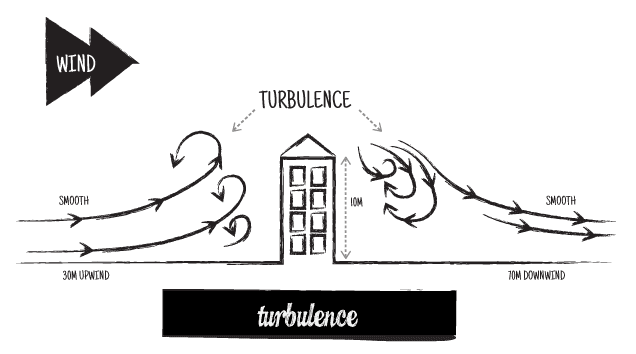Understanding Wind Flow
Except in volatile storms or pockets of unstable air, when the wind blows without obstruction it will flow in a smooth, or ‘laminar’, pattern. Much like a wide, slow river; the movement of water is easy to predict, but when you add bends, narrow gaps and weirs, things get different. We can’t see the wind, but we can predict how it will react to local effects.

Zones of turbulence are created when wind blows over a feature such as trees, buildings, high walls and other structures.
In close proximity, both downwind* and upwind** of an obstacle, wind will be very turbulent and you should NOT fly your kite in this zone. As you move away from the obstacle, the wind will get smoother. To find steady kiteable winds, follow these rules:
- Downwind turbulence zone: estimate the height of the obstacle, multiply it by 7, and that’s how far downwind you need to be for clear wind.
- Example: a house is 10m high with the wind blowing over it. Therefore, you must be at least 70m downwind of the house to find smooth wind.
- Upwind turbulence zone: estimate the height of the obstacle, multiply it by 3, and that’s how far upwind you need to be to escape turbulence.
- Example: a cliff is 50m high with the wind blowing against it and you are stood on the beach. You need to be 150m upwind of the cliff to escape turbulence.
*Downwind: When you have your kite in the sky, you will have your back to the wind. Everything in front of you is DOWNWIND.
**Upwind: And with your back to the wind and the kite in the sky, everything behind you is UPWIND.

 Free Delivery on all orders over £25
Free Delivery on all orders over £25 
